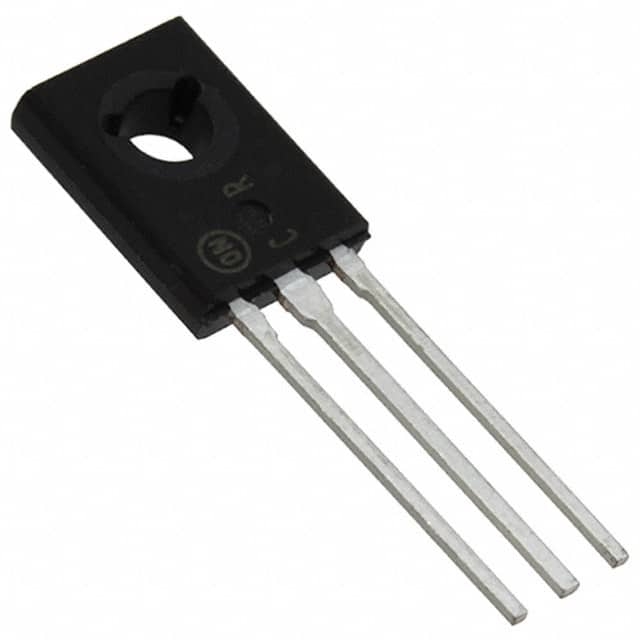Viz Specifikace pro podrobnosti o produktu.

BD137G - Transistor Encyclopedia Entry
Introduction
The BD137G is a type of transistor that belongs to the category of NPN bipolar junction transistors. This entry provides an overview of the basic information, specifications, detailed pin configuration, functional features, advantages and disadvantages, working principles, detailed application field plans, and alternative models of the BD137G.
Basic Information Overview
- Category: NPN Bipolar Junction Transistor
- Use: Amplification and switching applications
- Characteristics: High current gain, low saturation voltage
- Package: TO-126
- Essence: Silicon epitaxial planar NPN transistor
- Packaging/Quantity: Typically available in reels or tubes containing multiple units
Specifications
- Collector-Base Voltage (VCBO): 45V
- Collector-Emitter Voltage (VCEO): 45V
- Emitter-Base Voltage (VEBO): 5V
- Collector Current (IC): 1.5A
- Power Dissipation (PD): 12.5W
- Transition Frequency (fT): 100MHz
- Operating Temperature Range: -65°C to 150°C
Detailed Pin Configuration
The BD137G transistor has three pins: 1. Collector (C) 2. Base (B) 3. Emitter (E)
Functional Features
- High current gain
- Low saturation voltage
- Fast switching speed
- Suitable for audio amplification and general purpose switching applications
Advantages and Disadvantages
Advantages
- High current gain allows for efficient amplification
- Low saturation voltage minimizes power loss during switching
- Fast switching speed enables rapid on/off transitions
Disadvantages
- Limited maximum collector current compared to some alternative models
- Relatively lower transition frequency may restrict high-frequency applications
Working Principles
The BD137G operates based on the principles of bipolar junction transistors. When a small current flows into the base terminal, it controls a larger current between the collector and emitter terminals. This amplification or switching action forms the basis of its functionality.
Detailed Application Field Plans
The BD137G is commonly used in the following applications: - Audio amplifiers - Signal processing circuits - General purpose switching circuits - Driver circuits for relays and motors
Detailed and Complete Alternative Models
Some alternative models to the BD137G include: - BD138G - BD139G - 2N3904 - 2N2222A - BC547
In summary, the BD137G is a versatile NPN bipolar junction transistor with characteristics suitable for amplification and switching applications. Its high current gain, low saturation voltage, and fast switching speed make it a popular choice in various electronic circuits.
[Word Count: 398]
Seznam 10 běžných otázek a odpovědí souvisejících s aplikací BD137G v technických řešeních
What is the BD137G transistor used for?
- The BD137G is a PNP power transistor commonly used in audio amplifiers, voltage regulators, and other general-purpose applications.
What are the key specifications of the BD137G transistor?
- The BD137G has a maximum collector current of 1.5A, a maximum collector-emitter voltage of 60V, and a power dissipation of 12.5W.
Can the BD137G be used in audio amplifier circuits?
- Yes, the BD137G is suitable for use in audio amplifier circuits due to its high current and voltage ratings.
How should the BD137G be connected in a voltage regulator circuit?
- In a voltage regulator circuit, the BD137G can be connected as a series pass element to regulate the output voltage.
What are the typical applications of the BD137G in technical solutions?
- Typical applications include audio amplifiers, voltage regulators, motor control circuits, and general-purpose switching circuits.
What are the recommended operating conditions for the BD137G?
- The BD137G operates best within a temperature range of -65°C to 150°C and should be used with appropriate heat sinking if high power dissipation is expected.
Is the BD137G suitable for high-frequency applications?
- No, the BD137G is not designed for high-frequency applications due to its relatively low transition frequency.
Can multiple BD137G transistors be paralleled for higher current capability?
- Yes, multiple BD137G transistors can be paralleled to increase the overall current handling capability in a circuit.
What are the common failure modes of the BD137G transistor?
- Common failure modes include thermal runaway due to inadequate heat sinking, overcurrent leading to device breakdown, and voltage spikes causing damage.
Where can I find detailed application notes for using the BD137G in technical solutions?
- Detailed application notes and example circuits can often be found in the datasheet provided by the manufacturer or in technical reference manuals related to power transistors and amplifier design.

